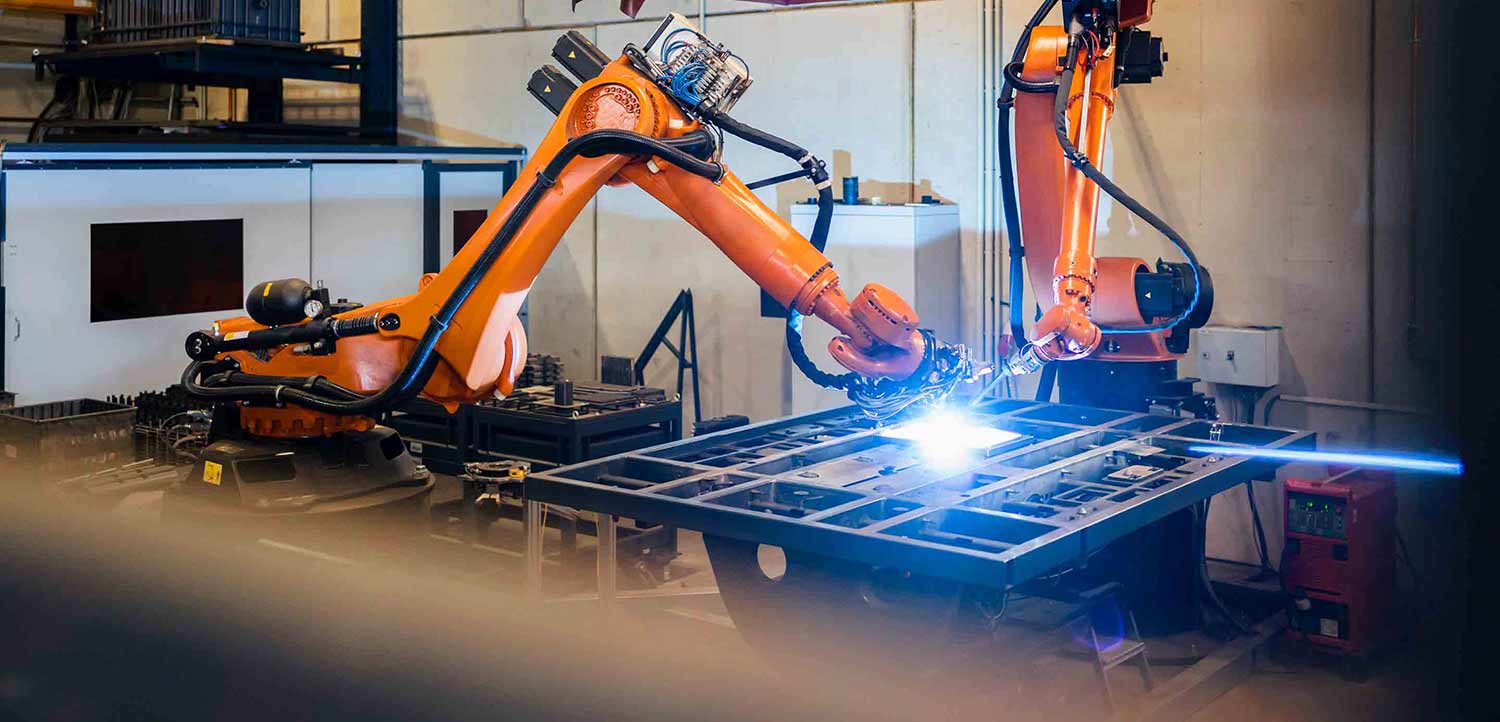- Article

- Accessing Capital
- Enable Growth
Making it here: how advanced manufacturing is driving growth in Asia
Manufacturing is a longstanding engine of growth in Asia, but the region is focused on rising up the value chain. How are businesses capturing opportunities from this shift?
Asia is the world’s factory floor. The region accounted for more than half of global manufacturing value-add in 2022, according to McKinsey.1 Making products for the rest of the world has been a cornerstone of economic development in Asia for decades, but the story is changing fast.
Basic manufacturing driven by low-cost labour is giving way to some of the world’s most advanced production facilities, making everything from semiconductors to solar panels. At the same time, supply chain diversification is creating opportunities for economies across Asia to rise up the value chain. Agile and innovative companies with international ambitions are poised to benefit.
Multiplier effect
It’s hard to overstate the economic multiplier effects of a dynamic manufacturing sector. In the US, for example, manufacturing only accounts for about 10% of national GDP and employment, but according to the US Bureau of Economic Analysis, it is responsible for 20% of capital investment, 35% of productivity growth, 55% of patents, 60% of exports, and 70% of business Research and Development expenditure in the country.2
Manufacturing facilities need infrastructure such as roads, ports, and utilities; their development creates jobs and can benefit other economic sectors.
China has famously harnessed manufacturing as a growth engine. What began in the modern era with low-cost factories in Shenzhen – the country’s first Special Economic Zone for foreign investors – in 1979 has evolved into one of the world’s most sophisticated production bases.
China has been the world’s biggest manufacturing economy for 13 years and is the leading producer of many advanced goods including electric vehicles, wind turbines and smartphones.3 Critically, the country has developed deep and complex supply chains around manufacturing hubs like Shenzhen, supported by advanced infrastructure, logistics and access to raw materials. Shenzhen ranks as the top Chinese city for new energy industries with over 24,000 new energy and digital energy companies, according to Hurun Research Institute.4
Upgrading manufacturing
Countries like India and Indonesia are seeking to achieve a similar transformation.
India’s government has implemented the Production Incentive Scheme (PLI) to attract investments to the country’s manufacturing sector and help make products made by its small- and medium-sized enterprises (SMEs) competitive worldwide.5
Initially introduced in March 2020 for the large-scale electronics manufacturing sector, the scheme was expanded in 2023 to cover 14 critical sectors, including automobiles and auto components, pharmaceuticals, textiles and apparel, high-efficiency solar energy equipment and processed foods.
Since 2016, India has also implemented a series of Phased Manufacturing Programmes to support local manufacturing through incentives and increasing the customs duty on imports. Starting with low-value phone accessories, programs have gradually moved on to focus on higher value components, including electric vehicles (EVs) in 2022.6
Indonesia’s policy, “Making Indonesia 4.0” aims to drive growth in five manufacturing sectors—food and beverages, textiles and clothing, automotive, chemicals and electronics—to build Indonesia’s global competitiveness and export potential, and make it a top-10 global economy by 2030.7 The Omnibus Law on Job Creation, passed in 2020, also sought to strengthen the economy by reducing bureaucracy and easing regulations to attract more multinationals to the country.11
And the Malaysian government launched the Industry4WRD strategy in 2018, aimed at optimising the conditions for technology-driven production processes and the usage of skilled labour in the manufacturing sector.8 Since then, the country has become a strong beneficiary of foreign direct investment, making it one of the top investment destinations in Southeast Asia. Malaysia approved total FDI of MYR125.7 billion (USD26.6 billion) for the first nine months of 2023, with a particularly strong showing in manufacturing projects in the semiconductor sector.9
Investing in innovation
In supportive policy environments like these, how do businesses capitalise on the shift to more advanced manufacturing in the region?
Investment in Research and Development is critical. High rates of R&D investment have driven innovation in the US, where R&D accounted for 3.46% of GDP in 2022, according to the European Union, compared with 2.23% in the EU itself and 2.41% in China, while South Korea invested nearly 5% of its GDP in R&D.10 Increasing R&D investment over the years ahead will help Asian businesses innovate and continue their move up the value chain.
Automation and digitalisation are becoming cornerstones of modern manufacturing.
Automation enhances efficiency, reduces costs, and minimises errors. Digitalisation can facilitate seamless connectivity, real-time data analysis, and simplified financial administration, allowing companies to focus on their core value proposition rather than support operations.
HSBC is supporting emerging business models in advanced manufacturing, such as Indian electric scooter producer Simple Energy, founded in 2019. With the R&D-intensive nature of electric vehicle manufacturing, businesses’ capital needs can be uneven. A company may require one large capital infusion during one cycle, but this could be followed by a long period in which capital needs are limited.
To ensure access to funding when required and a return on cash when it was not needed for capital expenditure, HSBC extended combined its commercial banking offering with wealth management services. The bank also dealt with the regulatory requirements associated with fundraising, freeing Simple Energy’s founders to focus on scaling their business.
Sustainable manufacturing
Growth in advanced manufacturing can go hand-in-hand with sustainable economic development.
Hong Kong-based manufacturer Pacific Textiles, which has operations in China, Sri Lanka and Vietnam, has invested significantly over the past 20 years to make its processes more sustainable. HSBC provided sustainable financing for the construction of Pacific Textiles’ new plant in Vietnam, which uses advanced equipment to improve energy efficiency in production and wastewater treatment.11
In Bangladesh, electronics and electrical goods manufacturer Walton Hi-Tech Industries PLC reflects the country’s efforts to move up the manufacturing value chain from its current focus on textiles. To ensure that shift aligns with Bangladesh’s environmental and climate objectives, Walton has set clear and ambitious targets to reduce its greenhouse gas emissions and groundwater consumption for every unit of production. HSBC extended sustainable financing to support Walton’s efforts.12
HSBC has also allocated a significant amount of capital to support innovative companies in various markets, including a USD3 billion New Economy Fund dedicated to providing tailored debt solutions to early-stage businesses across Hong Kong and mainland China from Series A onwards.13
Across the region, supportive policies are creating opportunities for advanced manufacturing businesses to grow – and bring benefits to the broader economy. Increased investment in R&D, automation and digitalization will be essential to moving up the value chain and securing the multiplier effects that will bring.
Manufacturing itself is changing fast, but its central place in Asian economies and the importance of financial support for businesses that make things is a constant. HSBC has been banking Asian manufacturers for nearly 160 years – and is committed to supporting innovative businesses that will drive tomorrow’s growth.
1 McKinsey: Cusp of a new era in Asia, 2023
2 McKinsey: Building a more competitive US manufacturing sector, 2021
3 https://www.chinadaily.com.cn/a/202309/25/WS6510c3bda310d2dce4bb7875.html
4 https://www.hurun.net/en-US/Info/Detail?num=BTIXK4H9WMC2
5 https://www.businessgo.hsbc.com/en/article/production-linked-incentive-scheme-pli-in-india
10 https://ec.europa.eu/eurostat/statistics-explained/index.php?title=R%26D_expenditure&oldid=551418
12 https://www.business.hsbc.com/en-gb/insights/sustainability/walton-hi-tech
13 https://www.business.hsbc.com.hk/en-gb/products/new-economy-fund
The information contained on this website is provided for informational purposes only, and does not constitute an offer to sell or the solicitation of an offer to buy any products referenced. Eligibility criteria and T&Cs apply for the products referenced. Local country restrictions and limits may apply. Please speak with your HSBC representative for more information.



